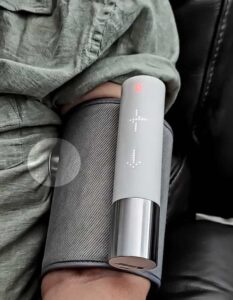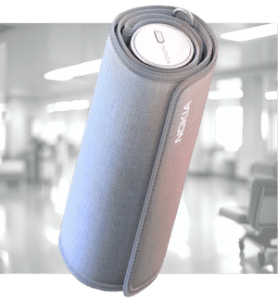In part 1 we looked at a low cost blood pressure (hypertension) monitor from Emporia, typical of its class and built around commodity components. As such, it represents a revolution in home health care, enabling anyone of relatively modest means easily to keep an eye on this important health parameter.
How important? The World Health Organisation estimates that worldwide about 1.28 billion adults between the ages of 30 and 79 have hypertension. And nearly half of them are unaware they have the condition.
We had some criticisms of the Emporia device. Its large, clear screen and its ability to read out its results would certainly be useful for the visually challenged. But it offered no easy way to collect these readings electronically for your private records or to share with a family doctor. More expensive blood pressure monitors address this problem.
One such is the Withings BPM Core. This is at the other end of the price spectrum from the Emporia BP51, a prestige product not destined for everybody’s domestic medical collection. With its additional sensors for collecting an electrocardiagram and listening for the distinctive sounds of misbehaving heart valves, you might think of it as the Apple Vision Pro of blood pressure monitors.
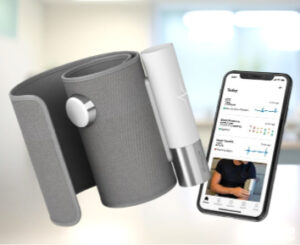 Selling on Amazon UK at just 5p less than £230, the Withings BPM Core is the most expensive consumer blood pressure monitor we’ve seen listed anywhere. It’s well made, certainly, and comes with a 2-year warranty. But the chief justification for its high price seems to be two additional features not found in other blood pressure monitors.
Selling on Amazon UK at just 5p less than £230, the Withings BPM Core is the most expensive consumer blood pressure monitor we’ve seen listed anywhere. It’s well made, certainly, and comes with a 2-year warranty. But the chief justification for its high price seems to be two additional features not found in other blood pressure monitors.
Delivering information about systolic and diastolic blood pressure, together with heart rate, and storing it internally, is the standard for the most basic of blood pressure monitors. A desirable additional feature, not available with the Emporia BP51, is the ability to transfer that information to your phone or computer for additional analysis and perhaps for sharing with your GP. The Withings BP Core does this too, as do most mid-range blood pressure monitors.
What the Withings BP Core offers beyond this seems to be, in the current market of mid-2023, unique. The device is also an ECG machine and an AI-assisted cardiologist.
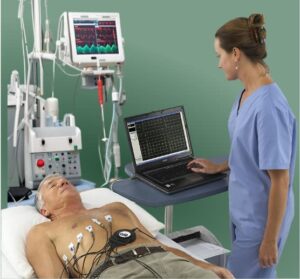 This is big news, so I should cut it down to size straight away. Whereas the ECG you’ll typically be wired up for in any professional consultation will be 12-channel, the Withings BPM Core is only reading a single channel. Under expert supervision, a 12-channel ECG can detect abnormalities across multiple regions of the heart. The Withings single channel ECG delivers only basic () information. While technically possible, the addition of more channels would complicate the device well beyond the competency of any domestic user.
This is big news, so I should cut it down to size straight away. Whereas the ECG you’ll typically be wired up for in any professional consultation will be 12-channel, the Withings BPM Core is only reading a single channel. Under expert supervision, a 12-channel ECG can detect abnormalities across multiple regions of the heart. The Withings single channel ECG delivers only basic () information. While technically possible, the addition of more channels would complicate the device well beyond the competency of any domestic user.
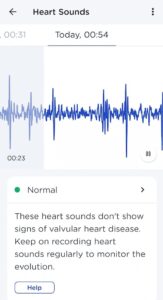 The expertise of Withings’ AI cardiologist, listening to the swish and woosh of your heart’s blood flow with the built-in stethoscope pressed against the left side of your rib cage, extends only to diagnosing heart valve function.
The expertise of Withings’ AI cardiologist, listening to the swish and woosh of your heart’s blood flow with the built-in stethoscope pressed against the left side of your rib cage, extends only to diagnosing heart valve function.
This is valuable health information. However, gathering meaningful data this way turns out to be a hit-and-miss process over several readings. I found that the typical report turning up on my phone after a heart sounds session would be “Inconclusive”. But over the course of a month’s use of the Withings BPM Core, “Heart Sounds Normal” has been returned occasionally, which is reassuring.
Taking the Readings
The usual rules apply: sit straight in your chair with your feet flat on the ground (not legs crossed). Breathe slowly and relax for five minutes. Slip your left hand through the BPM Core, silvered end down, and slide it up to your bare upper arm, with the lower edge roughly an inch above the bend of your elbow.
There are no particular instructions about aligning the cuff with the brachial artery. But if you want to include the ECG and heart sounds test that optionally immediately follows the blood pressure reading, you’ll need to ensure that the stethoscope is facing towards your rib cage. You’ll see why when we get to the description of the second phase.
Wrapping the BPM Core’s cuff around your upper arm is a little trickier than with a normal cuff. It’s spring-loaded into its curved shape, making it awkward to pull it open completely if you want to wind it round your arm as with a regular cuff. Slipping your hand into it and easing it up your arm seems to be the most practical way to get it on.
Once it’s on your upper arm you may struggle to rotate it to position the stethoscope towards your ribs but after a few sessions you quickly learn to adjust the orientation correctly before moving the cuff above your elbow.
Less easy to deal with is adjusting the tightness of the cuff once it’s in place. Before inflation and once you’ve locked the cuff by pressing the Velcro surfaces together, you should be able to slip two fingers between the cuff and your arm. But if the cuff is too loose or too tight, you’ll find yourself struggling against the spring loaded curve of the cuff to get it right.
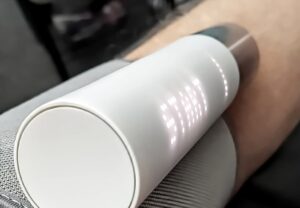 Now, with your left arm resting on a horizontal surface so that the BPM Core is roughly at the height of your heart, you press the large white button that forms the top of the BPM Core’s cylinder to switch it on.
Now, with your left arm resting on a horizontal surface so that the BPM Core is roughly at the height of your heart, you press the large white button that forms the top of the BPM Core’s cylinder to switch it on.
At this point, the low resolution dotty display comes on, illuminating the white surface of the cylinder with the word “Withings”. This quickly fades and is replaced with the word “START”. Pressing the button again powers up the cuff’s air pump and starts part one of the session.
However, one thing to notice before you do this is the white line at the end of the word “START”. It’s in motion, snaking up and down to remind you that by stroking the surface of the cylinder you can change the display. This opens up two additional options: START 3 and ECG.
START 3 means that instead of the default single reading, the BPM Core will take three successive readings and deliver the average. The delay between the readings can be set in the Withings app.
As you might expect, the EGC option allows you to skip the blood pressure reading and plunge straight into the ECG session.
The blood pressure part of the session takes about 40 seconds, depending on how long the air pump takes to create the pressure needed to shut down the brachial artery. Once that’s done, the display changes and an animated arrow points down towards the silver cap at the bottom of the cylinder. This indicates that the machine is ready for part 2, the ECG session.
The arrow is a reminder to grasp the silver cap with your right hand. This closes a circuit through your body from your right arm, across your chest and into your left upper arm, where it is in contact with a couple of large terminals inside the cuff. This is why putting the cuff on a bare arm is mandatory. The machine isn’t passing electricity through this circuit, it’s simply registering the electrical pulses produced by your heart.
While this is happening you also have the option to trigger the heart sounds function by pressing the disk of the stethoscope (highlighted in the picture) against your rib cage. This doesn’t require bare skin contact as the stethoscope can operate through a layer of clothing as long as it’s not too thick.
The BPM Core’s display changes to acknowledge the new functions. An animated graph indicates the ECG reading (it’s mostly cosmetic, although the recorded results that appear on your phone will be as accurate as the device can determine).
Delivering the Data
 At the end of the session the screen shows, in succession, your systolic, diastolic and heart rate readings. If you opted for the ECG option, these additional readings will only appear when transferred to your phone. If the BPM Core has detected atrial fibrillation, however, the information is flashed up on the device, accompanied by a red warning light.
At the end of the session the screen shows, in succession, your systolic, diastolic and heart rate readings. If you opted for the ECG option, these additional readings will only appear when transferred to your phone. If the BPM Core has detected atrial fibrillation, however, the information is flashed up on the device, accompanied by a red warning light.
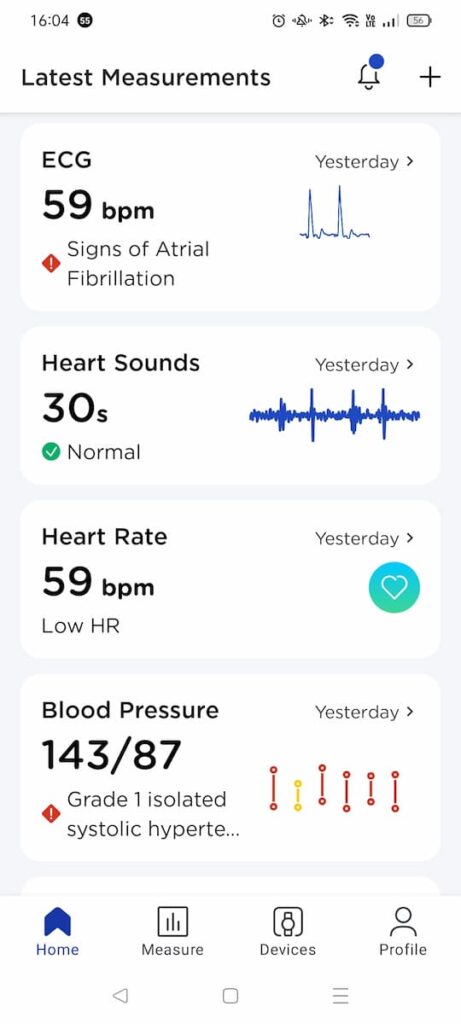 The Withings App
The Withings App
I tested the BPM Core with an Android phone; there is also an iOS version of the Withings app for the iPhone. The blood pressure device and the phone connect by default over your WiFi LAN, although they can fall back on Bluetooth if WiFi isn’t available.
There may be a lag of a few minutes before the readings appear on your phone. The ECG and heart sound information can turn up there tagged as “Processing”. This lets you know that the complex data is being run through Withing’s algorithms back at base. Heart sounds, in particular, seem to require several days’ worth of data before any conclusion is delivered.
Users have reported that heart sounds can remain tagged as “Inconclusive” even after many sessions. I found it necessary to experiment with the positioning of the stethoscope, so this may be due to user error.
Some History
The Withings acquisition became Nokia’s Digital Health division—but not for long. Unknown to Tested Technology at the time—and apparently also unknown to Nokia’s PR company that had sent us the BPM+—Nokia had already decided that its new Digital Health division was without any business value, had written off the cost of acquisition and was in discussions about selling it.
Within a few days of the BPM+ arriving at Tested Technology, Nokia had off-loaded its Digital Health division back to Éric Carreel, former Withings CEO and one of its original co-founders. What the reacquisition cost Carreel is undisclosed. But we can guess it left him plenty of change to nurse the company back to its current health.
A Haunting Analogy
Modern life is stressful for most of us, and I’m using that word in a medical sense. We may be well aware of the stress but are much less likely to be aware of the effect of the stress on our blood pressure. Or of the effect of that heightened blood pressure on our heart and our general health. That’s why they call hypertension “the silent killer”.
While this review was being written, a small US company tragically lost three of its members and two of its customers in a fatal disaster that strikes me as a haunting analogy to what we’re discussing here.
 The company’s chief physical asset was a 5-person deep dive submersible designed by the CEO, Stockton Rush. The vehicle, the Titan, built to withstand water pressure up to two miles below the ocean surface, imploded on the way down to view the famous wreck of the Titanic, instantly killing all on board, including Rush himself.
The company’s chief physical asset was a 5-person deep dive submersible designed by the CEO, Stockton Rush. The vehicle, the Titan, built to withstand water pressure up to two miles below the ocean surface, imploded on the way down to view the famous wreck of the Titanic, instantly killing all on board, including Rush himself.
The Titan had been two miles down to view the Titanic three times before, and YouTube has a marvellous video of one of those visits.
Rush had built the Titan from a cylindrical hull of five inch thick epoxy-soaked carbon fibre glued to titanium caps fore and aft. This novel method of construction rang warning bells among the deep sea engineering community. The conventional wisdom was that any composite of metal and carbon fibre would respond unpredictably to repeated stress. For engineers, that word “unpredictably” translates as “accident waiting to happen”.
To the more sceptical in the deep dive community it was an accident scheduled to happen. But Rush appeared to believe that these three successful deep dives refuted the naysayers. In fact, each dive would almost certainly have been insidiously weakening the structure.
Regular non-destructive inspection (NDI) of the hull would have been the industry standard. But Rush saw standards like this as the enemy of innovation. So the Titan held up against the immense external pressure of deep water—until one morning it didn’t.
You can find some useful additional information about hypertension here.
Chris Bidmead 10-Jul-23

